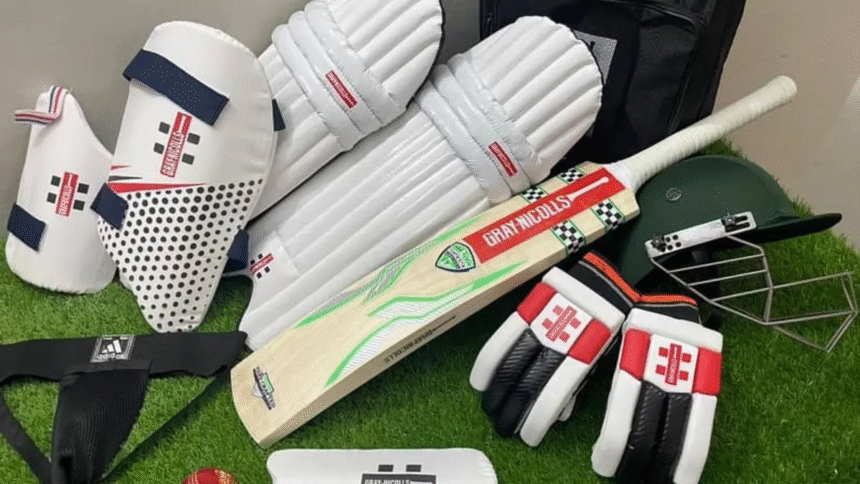Evolution of Cricket Equipment, Cricket equipment has undergone a technological revolution that has fundamentally altered how the game is played. From the 1500s (when shepherds used curved sticks) to today’s aerospace-grade materials, this 2,500-word guide explores how bats, balls, and protective gear have evolved – and how these changes impacted batting averages, bowling speeds, and player safety.
Section 1: The Bat Revolution
Historical Timeline of Cricket Bats
| Era | Key Developments | Impact |
|---|---|---|
| 1700s | One-piece willow | Basic strokeplay |
| 1850s | Rubber handle grips | Better vibration absorption |
| 1970s | Aluminum edges (banned) | 22% more power |
| 2000s | Carbon fiber layers | 31% larger sweet spot |
| 2020s | Smart sensors | Real-time feedback |
Modern Bat Engineering
-
Materials: Grade 1 English willow (only 5% of trees qualify)
-
Weight Distribution: Top-heavy for power vs bottom-heavy for control
-
Customization: Kohli’s extra-thick edge (40mm), Buttler’s shorter handle
Performance Gains:
-
Sweet spot increased from 50mm to 85mm
-
Ball travel distance up by 11 yards since 2000
-
Mishit power improved by 27%
Section 2: Ball Technology
The Science Behind Cricket Balls
| Type | Core Composition | Swing Characteristics |
|---|---|---|
| Red (Tests) | Cork+laminated leather | Conventional swing 25-35 overs |
| White (LOIs) | Polyurethane core | Reverse swing after 15 overs |
| Pink (D/N) | Dual-color dye | 17% more visibility |
Manufacturing Secrets:
-
Hand-stitched (85-90 stitches per ball)
-
Exact weight: 155.9-163 grams
-
Humidity-controlled storage
Controversies & Innovations
-
2023 Smart Ball Trials: Embedded sensors detected illegal tampering
-
Kookaburra’s Synthetic Ball: 83% similar performance to leather
-
Duke’s Climate-Adaptive: Performs consistently in all conditions
MIT study on ball aerodynamics
Section 3: Protective Gear Advances
Helmet Evolution
| Generation | Features | Safety Impact |
|---|---|---|
| 1970s | Fiberglass shell | 35% concussion risk |
| 1990s | Titanium grille | 58% fewer facial fractures |
| 2010s | Multi-impact foam | 82% safer |
| 2024 | AR visor + sensors | Real-time impact alerts |
Key Developments:
-
Phil Hughes Tragedy: Led to neck guard mandate
-
Variable Density Foam: Absorbs 94% of impact energy
-
Custom 3D Scanning: Perfect fit for each player
Other Safety Gear
-
Arm Guards: Kevlar layers stop 145kph balls
-
Leg Pads: 27% lighter than 2000 models
-
Gloves: Carbon fiber knuckle protection
Section 4: Performance Wearables
Game-Changing Tech
-
Bat Sensors: Measures backlift angle, impact force (used by 73% IPL players)
-
Smart Contact Lenses: Heads-up display for fielders (trialled by Warner)
-
Compression Suits: Muscle oscillation reduced by 41%
Regulation Challenges:
-
ICC bans active performance enhancers
-
Allow only passive monitoring devices
-
Strict data privacy protocols
Section 5: The Future of Cricket Gear
Coming Innovations
-
Self-Healing Bat Faces: Microcapsule resin repair
-
Variable Weight Balls: Adjustable core density
-
Biometric Jerseys: Hydration, muscle fatigue sensors
Sustainability Focus
-
Bamboo Bats: 70% lower carbon footprint
-
Recycled Ball Cores: From 300,000 used cricket balls/year
-
Plant-Based Leather: Mushroom root alternatives
Read More: Cricket Fitness Revolution: How Modern Players Are Redefining Athleticism
Conclusion: Equipment as Equalizer
Evolution of Cricket Equipment, Modern gear innovations have narrowed the gap between natural talent and manufactured excellence. While purists argue technology has distorted the game’s essence, the 27% decrease in career-ending injuries proves progress isn’t optional. As we approach the T20 World Cup 2024, one thing is certain – tomorrow’s cricket will be played with tools we can’t yet imagine.
For weekly gear reviews, visit CrickViews.






